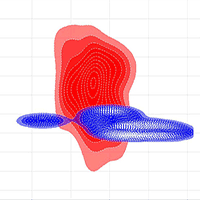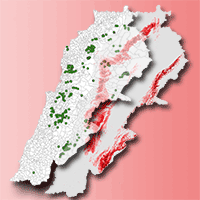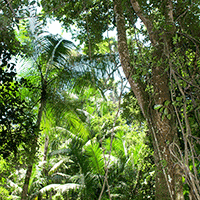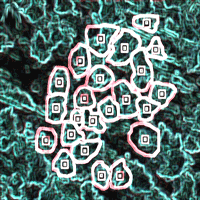Forest stand structural diversity can be examined at different scales. Small-scale structural changes are the basis of forest structural diversity and habitat heterogeneity, and play a key role in biodiversity conservation. Most research on forest structure has focused mainly at stand level and above, with little attention paid to fine-scale structure and correlations among different forest stand attributes. We set up four permanent plots within a secondary forest community of Pinus yunnanensis var. tenuifolia mixed forests along the Nanpan River in southern China. We analyzed their nearest-neighbor relationships using a bivariate distribution of stand spatial structural parameters (SSSP) with the aim of understanding the processes that drive structural diversity in the development of a secondary forest community. Our results revealed that communities with different disturbance histories and species compositions differed in the level of species mixture. Large, small, and medium-sized trees were well mixed within the community, both conspecific and heterospecificindividual with varying densities. All plots exhibited a uniform size differentiation pattern. Trees with different dominance levels or mixture levels were randomly distributed within the plots, and only few of these displayed clumped or regular distribution. Pearson’s correlation analysis revealed that distribution patterns may be related to species composition and diameter differentiation, though their relationship was very weak. The results of this study are relevant to optimize forest management activities in the studied stands, and promote tree growth, regeneration and habitat diversity at the fine scale.
Keywords
, , , ,
Citation
Li Y, Hui G, Yu S, Luo Y, Yao X, Ye S (2017). Nearest neighbour relationships in Pinus yunnanensis var. tenuifolia forests along the Nanpan River, China. iForest 10: 746-753. - doi: 10.3832/ifor2405-010
Academic Editor
Matteo Garbarino
Paper history
Received: Feb 12, 2017
Accepted: Jun 04, 2017
First online: Aug 01, 2017
Publication Date: Aug 31, 2017
Publication Time: 1.93 months
© SISEF - The Italian Society of Silviculture and Forest Ecology 2017
Open Access
This article is distributed under the terms of the Creative Commons Attribution-Non Commercial 4.0 International (https://creativecommons.org/licenses/by-nc/4.0/), which permits unrestricted use, distribution, and reproduction in any medium, provided you give appropriate credit to the original author(s) and the source, provide a link to the Creative Commons license, and indicate if changes were made.

Breakdown by View Type
(Waiting for server response...)
Article Usage
Total Article Views: 47839
(from publication date up to now)
Breakdown by View Type
HTML Page Views: 40051
Abstract Page Views: 3082
PDF Downloads: 3591
Citation/Reference Downloads: 15
XML Downloads: 1100
Web Metrics
Days since publication: 3043
Overall contacts: 47839
Avg. contacts per week: 110.05
Article Citations
Article citations are based on data periodically collected from the Clarivate Web of Science web site
(last update: Mar 2025)
Total number of cites (since 2017): 19
Average cites per year: 2.11
Publication Metrics
by Dimensions ©
Articles citing this article
List of the papers citing this article based on CrossRef Cited-by.
(1)
Adekunle VAJ, Olagoke AO (2008)Diversity and biovolume of tree species in natural forest ecosystem in the bitumen-producing area of Ondo State, Nigeria: a baseline study. Biodiversity and Conservation 17: 2735-2755.
CrossRef |
Gscholar
(2)
Anonymous (1960)Preliminary studies on regeneration and final felling of
Pinus yunnanensis Franchet (Guangxi Zhuang Autonomous Region Forestry Research Institute, Guangxi Baise forestry experimental station, Lingle sub-bureau attached to Guangxi forest industry bureau, Guangxi Lingle forestry farm eds). Scientia Silvae Sinicae 1: 44-54.
Gscholar
(3)
Baskent EZ, Keles S (2005)Spatial forest planning: a review. Ecological Modelling 188: 145-173.
CrossRef |
Gscholar
(4)
Boncina A (2000)Comparison of structure and biodiversity in the Rajhenav virgin forest remnant and managed forest in the Dinaric region of Slovenia. Global Ecology and Biogeography 9: 201-211.
CrossRef |
Gscholar
(5)
Castaño-Villa GJ, Ramos-Valencia SA, Fontúrbel FE (2014)Fine-scale habitat structure complexity determines insectivorous bird diversity in a tropical forest. Acta Oecologica 61: 19-23.
CrossRef |
Gscholar
(6)
Chu C, Mortimer PE, Wang H, Wang Y, Liu X, Yu S (2014)Allelopathic effects of
Eucalyptus on native and introduced tree species. Forest Ecology and Management 323: 79-84.
CrossRef |
Gscholar
(7)
Churchill DJ, Larson AJ, Dahlgreen MC, Franklin JF, Hessburg PF, Lutz JA (2013)Restoring forest resilience: from reference spatial patterns to silvicultural prescriptions and monitoring. Forest Ecology and Management 291: 442-457.
CrossRef |
Gscholar
(8)
Coomes DA, Allen RB (2007)Effects of size, competition and altitude on tree growth. Journal of Ecology 95: 1084-1097.
CrossRef |
Gscholar
(9)
Fan G, Xue J (1993)Distributional characteristics of
Pinus L. in southeast Yunnan. Guihaia 13: 349-354.
Gscholar
(10)
Franklin JF, Mitchell RJ, Palik B (2007)Natural disturbance and stand development principles for ecological forestry. General Technical Report NRS-19, Northern Research Station, USDA Forest Service, DE, USA, pp. 44.
Online |
Gscholar
(11)
Frazer GW, Wulder MA, Niemann KO (2005)Simulation and quantification of the fine-scale spatial pattern and heterogeneity of forest canopy structure: a lacunarity-based method designed for analysis of continuous canopy heights. Forest Ecology and Management 214: 65-90.
CrossRef |
Gscholar
(12)
Getzin S, Dean C, He F, Trofymow J, Wiegand K, Wiegand T (2006)Spatial patterns and competition of tree species in a Douglas-fir chronosequence on Vancouver Island. Ecography 29: 671-682.
CrossRef |
Gscholar
(13)
Graz FP (2004)The behaviour of the species mingling index Msp in relation to species dominance and dispersion. European Journal of Forest Research 123: 87-92.
CrossRef |
Gscholar
(14)
Hui G, Gadow KV (2003)Quantitative analysis of forest spatial structure. China Science and Technology Press, Beijing, China, pp. 27-62.
Gscholar
(15)
Hui G, Gadow KV, Zhao Z, Hu Y, Xu H, Li Y, Zhang L, Zhang G, Liu W, Yuan S (2016)Principles of structure-based forest management. China Forestry Publishing House, Beijing, China. pp. 23-102.
Gscholar
(16)
Janda P, Svoboda M, Bače R, Cada V, Peck JE (2014)Three hundred years of spatio-temporal development in a primary mountain Norway spruce stand in the Bohemian Forest, central Europe. Forest Ecology and Management 330: 304-311.
CrossRef |
Gscholar
(17)
Janík D, Adam D, Hort L, Král K, Ašamonil P, Unar P, Vrška T (2014)Tree spatial patterns of
Abies alba and
Fagus sylvatica in the Western Carpathians over 30 years. European Journal of Forest Research 133: 1015-1028.
CrossRef |
Gscholar
(18)
Kint V (2005)Structural development in ageing temperate Scots pine stands. Forest Ecology and Management 214: 237-250.
CrossRef |
Gscholar
(19)
Kint V, Lust N, Ferris R, Olsthoorn AFM (2000)Quantification of forest stand structure applied to Scots pine (
Pinus sylvestris L.) forests. Investigación Agraria: Sistemas y Recursos Forestales, Fuera de serie 1: 147-163.
Online |
Gscholar
(20)
Kint V, Meirvenne MV, Nachtergale L, Geuden G, Lust N (2003)Spatial methods for quantifying forest stand structure development: a comparison between nearest-neighbor indices and variogram analysis. Forest Science 49: 36-49.
Online |
Gscholar
(21)
Knoke T, Seifert T (2008)Integrating selected ecological effects of mixed European beech-Norway spruce stands in bioeconomic modeling. Ecological Modeling 210: 487-498.
CrossRef |
Gscholar
(22)
Kuuluvainen T, Wallenius TH, Kauhanen H, Aakala T, Mikkola K, Demidova N, Ogibin B (2014)Episodic, patchy disturbances characterize an old-growth
Picea abies dominated forest landscape in northeastern Europe. Forest Ecology and Management 320: 96-103.
CrossRef |
Gscholar
(23)
Li Z, Wang X (1981)The distribution of
Pinus yunanensis var.
tenuifolia in relation to the environmental conditions. Acta Phytoecologica et Geobotanica Sinica 5: 28-37.
Gscholar
(24)
Li J (2008)Study on the quantitative analysis of the oak natural secondary forest in Baotianman nature reserve. Master thesis, Henan Agriculture University, Zhengzhou, Henan, China, pp. 52-66.
Gscholar
(25)
Li Y, Hui G, Zhao Z, Hu Y (2012)The bivariate distribution characteristics of spatial structure in natural Korean pine broad-leaved forest. Journal of Vegetation Science 23: 1180-1190.
CrossRef |
Gscholar
(26)
Li Y, Hui G, Zhao Z, Hu Y, Ye S (2014a)Spatial structural characteristics of three hardwood species in Korean pine broad-leaved forest - validating the bivariate distribution of structural parameters from the point of tree population. Forest Ecology and Management 314: 17-25.
CrossRef |
Gscholar
(27)
Li Y, Ye S, Hui G, Hu Y, Zhao Z (2014b)Spatial structure of timber harvested according to structure-based forest management. Forest Ecology and Management 322: 106-116.
CrossRef |
Gscholar
(28)
Li Y, Wang L, Yu S, Ye S, Lu D (2016)Spatial structure of
Syzygium hancei community along coastline of Guangxi. Chinese Journal of Ecology 35: 726-732.
Online |
Gscholar
(29)
Muscolo A, Bagnato S, Sidari M, Mercurio R (2014)A review of the roles of forest canopy gaps. Journal of Forestry Research 25: 725-736.
CrossRef |
Gscholar
(30)
Ni R, Baiketuerhan Y, Zhang C, Zhao X, Gadow KV (2014)Analysing structural diversity in two temperate forests in northeastern China. Forest Ecology and Management 316: 139-147.
CrossRef |
Gscholar
(31)
Peck JE, Zenner EK, Brang P, Zingg A (2014)Tree size distribution and abundance explain structural complexity differentially within stands of even-aged and uneven-aged structure types. European Journal of Forest Research 133: 335-346.
CrossRef |
Gscholar
(32)
Petritan IC, Commarmo B, Hobi ML, Petritan AM, Bigler C, Abrudan IV, Rigling A (2015)Structural patterns of beech and silver fir suggest stability and resilience of the virgin forest Sinca in the Southern Carpathians, Romania. Forest Ecology and Management 356: 184-195.
CrossRef |
Gscholar
(33)
Pommerening A (2002)Approaches to quantifying forest structures. Forestry 75: 305-324.
CrossRef |
Gscholar
(34)
Pommerening A (2006)Evaluating structural indices by reversing forest structural analysis. Forest Ecology and Management 224: 266-277.
CrossRef |
Gscholar
(35)
Pommerening A, Stoyan D (2006)Edge-correction needs in estimating indices of spatial forest structure. Canadian Journal of Forest Research 36 (7): 1723-1739.
CrossRef |
Gscholar
(36)
Potvin C, Dutilleul P (2009)Neighborhood effects and size asymmetric competition in a tree plantation varying in diversity. Ecology 90: 321-327.
CrossRef |
Gscholar
(37)
Sheng Z, Xie S, Pan C (2010)Probability and mathematical statistics. Higher Education Press, Beijing, China, pp. 30-120.
Gscholar
(38)
Silver EJ, D’Amato AW, Fraver S, Palik BJ, Bradford JB (2013)Structure and development of old-growth, unmanaged second-growth, and extended rotation
Pinus resinosa forests in Minnesota, USA. Forest Ecology and Management 291: 110-118.
CrossRef |
Gscholar
(39)
Spies TA (1998)Forest structure: a key to the ecosystem. Northwest Science 72: 34-36.
Gscholar
(40)
Svebsson JS, Jeglum JK (2001)Structure and dynamics of an undisturbed old-growth Norway spruce forest on rising Bothnian coastline. Forest Ecology and Management 151: 67-79.
CrossRef |
Gscholar
(41)
Takashi K, Mitsuishi D, Uemura S, Suzuki JI, Hara T (2003)Stand structure and dynamics during a 16-year period in a sub-boreal conifer-hardwood mixed forest, northern Japan. Forest Ecology and Management 174: 39-50.
CrossRef |
Gscholar
(42)
Tuten MC, Meador AS, Fulé PZ (2015)Ecological restoration and fine-scale forest structure regulation in southern ponderosa pine forests. Forest Ecology and Management 348: 57-67.
CrossRef |
Gscholar
(43)
Vilhar U, Simončič P (2012)Water status and drought stress in experimental gaps in manager and semi-natural silver fir-beech forests. European Journal of Forest Research 131: 1381-1397.
CrossRef |
Gscholar
(44)
Wang X (1991)The phytocoenological features of
Pinus yunnanensis var.
tenuifolia forest in Guangxi. Bulletin of Botanical Research 11: 91-103.
Gscholar
(45)
Wehenkel C, Brazão-Protázio JM, Carrillo-Parra A, Martínez-Guerrero JH, Crecente-Campo F (2015)Spatial distribution patterns in the very rare and species-rich
Picea chihuahuana tree community (Mexico). PloS ONE 10: e0140442.
CrossRef |
Gscholar
(46)
Yang B, Li D (1988)The fertility characteristics of soil in the distribution area of
Pinus yunnanensis var.
tenuifolia in Yachang, Guangxi. Journal of Guangxi Agricultural College 7: 27-33.
Gscholar
(47)
Zhao Z, Hui G, Yuan S, Liu W, Wang R (2009)Spatial structure characteristics of
Quercus aliena var.
acuteserrata natural forest in Xiaolongshan. Scientia Silvae Sinicae 45: 1-6.
Gscholar


















